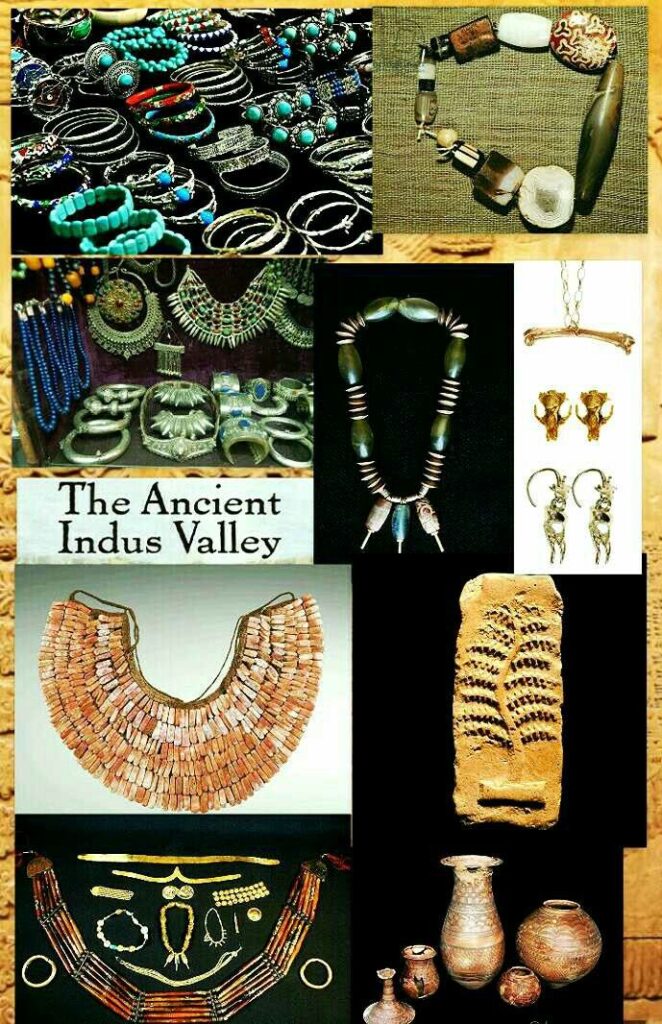🕰️ 1. Introduction and Time Period
The Harappan or Indus Valley Civilisation was one of the earliest urban civilisations in the world. It flourished between 2600 BCE to 1900 BCE and is divided into three phases: Early Harappan (6000–2600 BCE), Mature Harappan (2600–1900 BCE), and Late Harappan (1900–1300 BCE). Its remains have been found in present-day Pakistan and north-west India, spread across Gujarat, Rajasthan, Haryana, Punjab, and parts of Afghanistan.
🔹 Also called Indus Valley Civilisation
🔹 Named after the city of Harappa (first site discovered)
🔹 Over 2000+ sites found

🧱 2. Town Planning and Architecture
One of the most remarkable features of the Harappan cities like Mohenjodaro and Dholavira was their planned layout. Cities were divided into two parts — the Citadel (higher, for public buildings) and the Lower Town (residential). Streets were laid in a grid pattern, intersecting at right angles.
Buildings were made with standard-sized baked bricks (ratio 4:2:1). Drainage systems ran along the streets and were covered, showing high civic sense.
🔹 Great Bath at Mohenjodaro – used for ritual bathing
🔹 700+ wells in Mohenjodaro – shows water management
🔹 Multi-storey houses, private bathrooms and courtyards
🌾 3. Economy and Agriculture
Harappans practiced agriculture, animal husbandry, and trade. Archaeological evidence shows they grew wheat, barley, rice, lentils, sesame, millets, etc. Domesticated animals included cattle, buffalo, goat, pig, and fish. Farming was supported by irrigation using wells and reservoirs.
🔹 Ploughed fields found in Kalibangan
🔹 Terracotta plough models in Banawali
🔹 Use of saddle querns for grinding grains
🪦 4. Social Life and Burials
Social structure in Harappan society can be understood from burials and artefacts. Most people were buried in simple pit graves; some graves had pottery, ornaments, or tools. Both men and women were found buried with jewellery, suggesting some level of equality.
Rare and luxury items were found mostly in large cities, indicating social differentiation.
🔹 Examples: faience pots, copper mirrors, gold ornaments
🔹 Some graves lined with bricks – may indicate higher status
🎨 5. Craft and Technology
Harappans were skilled in craft production. Sites like Chanhudaro specialised in bead-making, Nageshwar and Balakot in shell-work. Beads were made from carnelian, steatite, jasper, gold, and terracotta.
Production involved cutting, polishing, drilling and sometimes using paste moulding. Tools made of copper, bronze and stone have also been found.
🔹 Use of specialised drills
🔹 Reject pieces and waste found at craft sites
🔹 Pottery was both utilitarian and decorative
🚚 6. Trade and Foreign Contacts
Harappans had a flourishing internal and external trade system. Goods were transported via bullock carts, boats, and river routes. Foreign trade was with Mesopotamia (Meluhha), Oman (Magan) and Bahrain (Dilmun).
Items like lapis lazuli, copper, gold, timber were imported, and beads, seals, and pottery were exported.
🔹 Harappan seals and jars found in Oman and Mesopotamia
🔹 Use of Harappan weight systems even in foreign lands
🧾 7. Script, Seals and Weights
The Harappans used seals made of steatite, often with animal motifs and inscriptions. Their script is undeciphered and had about 400 symbols. It was likely written right to left.
Weights were made of chert and were cubical in shape. They followed binary (1, 2, 4, 8) and decimal systems (160, 320), showing standardisation in trade.
🔹 Seals used for identity and transport sealing
🔹 Writing found on seals, copper tools, pottery, tablets
👑 8. Political Structure
There is no clear evidence of kings or palaces in Harappan cities. Some believe there was centralised control, as seen by uniform bricks and city planning. Others suggest regional rulers or even a society with equal status.
🔹 “Priest-King” statue is symbolic, not proven
🔹 Large public structures may show organised administration
🛑 9. Decline of Civilisation
The Harappan civilisation began to decline around 1900 BCE. Mature features like writing, seals, weights, and urban planning disappeared. Reasons for decline may include:
- Climate change or floods
- River drying or shifting
- Deforestation or overuse of land
People moved towards rural life, and new settlements arose in Gujarat, Haryana, and western UP.
🧬 10. New Discoveries – Rakhigarhi DNA
Recent DNA studies at Rakhigarhi (Haryana) revealed that Harappans were indigenous people of the region. There is genetic continuity till modern times.
🔹 No proof of Aryan invasion
🔹 Shows cultural and genetic continuity for over 5000 years
✅ Final Touch:
This chapter helps understand how archaeologists interpret artefacts and reconstruct the past using tools, pottery, burials, architecture, and genetics.

